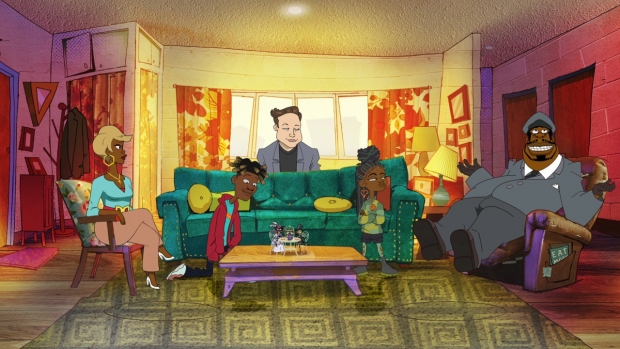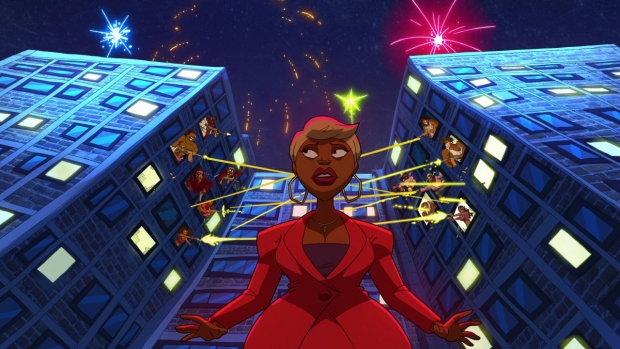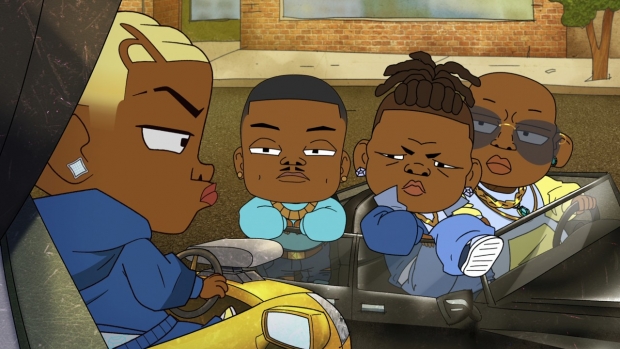The showrunner and executive producer of Netflix’s controversial, all-new adult animated show, based on the ground-breaking 1974 CBS sitcom, discusses how her upbringing and identity as an adopted Cuban child to Black parents on Chicago’s south side informs her creative decision-making and inspires the show’s loud animation style and edgy comedy.
When Eric Monte and Mike Evans’ three-time Golden Globe-nominated Good Times first aired on CBS in 1974, the tempo was gentle, and the satire was smooth. Ranada’s Shepard’s new animated series of the same name, a re-imagining of the original series set in the world of today, simply put, is quite different. The show has edge, as does the animation, which makes the most of hard lines and geometrical shapes, and it’s easy to see why the show fits so snuggly in the adult animation category.
But not everyone has cozied up to the animation reboot. And Shepard isn’t surprised.
Produced by Sony Picture Television with Act III Productions and Fuzzy Door Productions, the 2D-animated Good Times finds the fourth generation of the Evans family living in apartment 17C, in the last remaining housing projects in Chicago. The star-studded cast includes the voices of JB Smoove, Yvette Nicole Brown, Jay Pharoah, Marsai Martin, Slink Johnson, and Rashida “Sheedz” Olayiwola. Now available to stream on Netflix, the series is assisted in animation by Six Point Harness and Studio Moshi.
Check out the trailer:
The late Norman Lear, who developed the original live-action series, serves as executive producer with Shepard and Seth MacFarlane on the animated show. Shepard, one of the few Afro-Latina showrunners on an animated project in the industry, is the first to admit the show is a gritty departure from its wholesome inspiration. As far as the animation goes, nothing is romanticized or a perfect shape. Characters and their environments are distorted, but vivid and colorful, reflective of Shepard’s perspective growing up on Chicago’s South Side.
The personalities of the characters themselves are also loud, at times crass, and rough around the edges. But, in an interview with AWN, Shepard made it clear that the heart of the show is still love, family and what it means to navigate a world as unforgiving as the hard lines of animation.
In our chat with Shepard – who’s recently come from writing on Matthew A. Cherry’s Young Love – she talked about her own history with the original Good Times, growing up as an adopted Cuban child to Black parents, how becoming a parent herself led her to join the board of Dr. Queenie Johnson’s Black School Inc., and what all this has to do with her goals for Good Times. She also responded to the ridicule the show has received and why she stands by the series and the choices made by her and the team.
Victoria Davis: Outside of getting to work with Sony, what was the big draw for you in getting involved with this animated series? Were you a fan of the original show before coming on board?
Ranada Shepard: I grew up on the south side of Chicago, so I was a huge fan of the show. The reruns would air late at night and on the weekends and I was glued to the television.
VD: The original Good Times is said to have been ‘history-making’ in that it was the first African American two-parent family sitcom. We’ve had a handful of those shows since then. So, what do you feel makes the animated show unique, carrying on that history-making legacy?
 RS: If one’s basing the legacy of the show on a two-parent household, yes that still exists in the re-imagination. But we’ve also had a Black president and currently a Black female vice-president. A lot has changed since 1979, when the show ended, and there’s a lot more to talk about.
RS: If one’s basing the legacy of the show on a two-parent household, yes that still exists in the re-imagination. But we’ve also had a Black president and currently a Black female vice-president. A lot has changed since 1979, when the show ended, and there’s a lot more to talk about.
The stories we tell and the ways in which we use animation to tell the stories will keep the history-making legacy alive for this re-imagination.
VD: How did you decide on the show’s animation style? What were the visual goals you had for this series?
RS: The show was sold as an adult animation, so I showed up ready to play. The first set of visual goals was for the family to look like people I know, people who had a familiarity to them and with the intent to give them the attention and care Black animated characters have never had. Beyond that, textures and colors that make the animation specific to Chicago were important, as well as containing a familiarity to the original series, especially with them living in the same 17C unit.
VD: It’s interesting how the animated series focuses on the setting as the last remaining housing project in Chicago. I don’t think many people know the history or current state of the housing projects. Did you and the team have to do a lot of research during this series?
RS: These were breakfast and dinner conversations I had every week of my life, so the knowledge was commonplace for me. If it wasn’t my parents discussing it, we were watching it on the news. That conversation went from discussing our block one week and the projects the next. Not everyone in the show’s writers’ room had that upbringing.
My staff writer, Rashida “Sheedz” Olayiwola, is from Chicago and those conversations were a part of her life as well. But for the other writers, I led deep dives and had them research so that we were all coming into it with a perspective of compassion for the tenants. That was extremely important to me, that writers were knowledgeable and led with empathy and compassion.
VD: Being one of the industry’s only Afro-Latina showrunners on an animated project, was there any aspect of your own experience and family history infused into this show? Especially considering you're also a mother yourself?
RS: My upbringing is extremely unique. Most Afro-Latina people I encounter are rooted in Latin culture. I was adopted at birth by a Black A.D.O.S. (American Descendants of Slavery) family. It wasn’t until I met my birth family in my late 20’s that I learned of my Cuban heritage. By that time, my identity had been shaped and formed from a Black perspective, and a place of Black self-love.
So, every character and story are traced back to a personal story from my life or Sheedz’s life or family. This made this project extremely personal and loving. And that helped in shaping more stories.
VD: Along with your work in the entertainment industry, you’re also a board member of Black School, which helps Black children celebrate their identity, culture, and voice, while attending predominately white institutions. How do you feel your work on Good Times speaks to Black School's mission?
RS: Growing up on the south side of Chicago, you are always in an all-Black setting. When raising my kids in the San Fernando Valley in California, in each school they attended, they were either the only Black kid or they were one of maybe two, and I watched my kids struggle with their identity and self-love.
I had the gift of Dr. Queenie Johnson being my son's second-grade teacher, and with the help of my son and a handful of other kids, they formed this organization, Black School, to assist Black students with cultivating a strong ethnic identity and developing leadership skills. They currently have over 200 members and provide a sense of self-love, education, and life skills. Serving on that board is important to me because, based on my life and my journey, I’m super aware of how important identity is for kids.
VD: It’s no secret that this series has been a hot topic on the internet, with critics fanning the flames of the ridicule the show has received from some viewers. What’s your response to the harsh things being said about the show?
RS: I’m extremely proud of the show. I stand behind every story and every episode, and if these episodes leave people talking, that’s what they were designed to do.
I do regret that the cast and I were not able to get ahead of the show and frame it in a way that would have prepared the audience for the show. It can be a bit jolting to go from the original Good Times, which is a sweet sitcom format, and jump to this re-imagination that lives in the adult animation genre. The genre alone is loud, over-the-top, inappropriate at times, and edgy. So, I understand it can be off-putting for a lot of people who were expecting something else, like something softer and sweeter.
VD: What are your hopes for Good Times following this release?
RS: If you stick with it, the stories have so much meaning, heart, and powerful social commentary. My hope for Good Times is that people enjoy it, laugh, and feel proud of the content. I also hope that the social commentary promotes conversation in Black households, which families typically shy away from.












